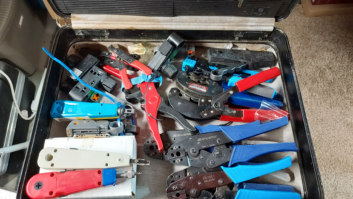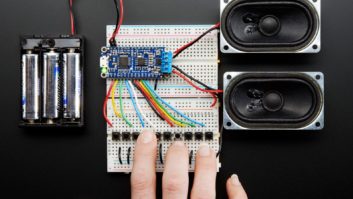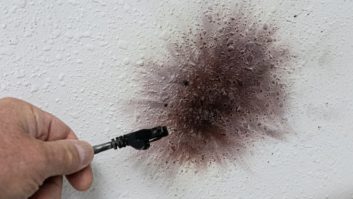Gather ’round, boys and girls, as Grandpa Lampen continues his journey through the history of wire and cable.
I left our column in the Sept. 25 issue talking about technology found, and lost, and rediscovered. We will see this a lot in our journey. I may take a liberty here and there by talking about “telecommunications” instead of just wire and cable. But in each instance we’ll find some version of wire and cable allowing the technology to work.
The word wire in English dates from before 900 AD, from the Old English word wir. A similar word, meaning a thin round elongated piece of metal, appears in old Norse languages. It’s probably also related to an old German word “wira,” which meant fine work in gold jewelry, which looked like wires, I would think. The word “cable” probably is from the Latin capulare, which mean a rope or halter such as that used with horses or cattle.
You can see that “vine” and “wine” share the same root. This makes sense; wire is like a vine, or vines are kind of “wiry.” Engineers will be happy to know that “wire” and “wine” are related. So fill your glass and toast those whose intellect and curiosity forged new (conductive) paths.
Nerds and dead frogs
Our next stop is the year 1729. That was when Stephen Gray (1667-1736) discovered that the electric force, made by rubbing glass, could be sent long distances over a wire.
Electricity had been produced by rubbing objects since the time of the ancient Greeks. Elektron, from which electricity is named, means “amber” in Greek. Amber, when rubbed, is a good source for static electricity.
In his earlier experiments, Gray suspended himself and became the conductor to prove his point. The charge from one object can be transferred to another by the use of a conducting material, in this case himself. He did the same experiment using wire, which must have been a lot easier on his body. He also concluded that there were conductors and non-conductors (insulators).
We move on to Pieter van Musschenbroek (1692-1761). In January 1746, he perfected the Leyden Jar, a device made by putting metal layers inside and outside a glass jar. It became a capacitor; it could store a charge. Van Musschenbroek would charge these up and arrange them in series, connected with wires. In his experiments, he and his assistants touched the end wires of the charged Leyden Jars and received nasty shocks, even rendering an assistant unconscious for a few seconds. A whole series of new Dutch swear words were born.
Around 1775, Henry Cavendish (1731-1810) put experiment and theory together and invented “capacitance” and “resistance.” In his experiments with resistance, he measured the current on a wire by touching it and estimating the pain. Most of his work was not published until a century later. He was deathly afraid of women, and only one quick sketch of him remains. Maybe the first real nerd.
In Italy, in 1793, Count Alessandro Volta (1745-1827) performed all sorts of experiments with frogs, getting their little dead muscles to twitch with electrical pulses. In doing so, it became apparent that different metals, with the liquid in the frog, could produce the animating voltage.
By creating layers of alternating metals, copper and zinc, separated by thick paper soaked in salt water, he produced the first modern battery, called the Voltaic Pile. Hey, it only took exactly 2,000 years to re-invent the battery. (You did read last month’s column, didn’t you?) The volt is named for him. He also discovered the idea of a circuit, in which electricity passes from pole to pole, and that a circuit must be complete before current can flow.
Needles and silk
If you can time-travel, you might want to visit the garden of Sir Francis Ronalds in Hammersmith, London, in 1816. He had more than eight miles of wire strung in his garden. Using just static electricity, he could send a charge down each wire. The charge attracted a little cork ball suspended near the end of the wire. As the ball moved, it revealed a letter. In this way messages could be sent. The British Navy was not impressed.
In 1820, Hans Christian Oersted (1777-1851) discovered that electric current flowing in a wire caused a compass needle to move. This indicated a relationship between electricity and magnetism. Only a week later, Andre Marie Ampere (1775-1836) discovered that parallel currents oppose each other and opposite currents attract. This led to the theory of Michael Faraday (1791-1867), who wondered in 1831: If electricity could produce magnetism, why couldn’t magnetism produce electricity?
Indeed it could, and the electric generator and motor were born.
In 1826, George Simon Ohm (1787-1854) determined that the current in a wire was related directly to the voltage of the source and the resistance of the wire. This relationship was so controversial that he delayed publishing these results, now known as Ohm’s Law, for a number of years.
In 1830, Joseph Henry (1797-1878) was teaching a class. He said, in effect, that there is no connection between electricity and magnetism. To prove it, he energized a wire, running near a second wire with a crude meter that showed electrical current. When he energized the first circuit, the meter moved. He had failed to prove his point.
Not only that, he found that, if he coiled up one or both wires, he could intensify the effect. And if he wrapped the wire around a piece of iron, the intensity of the magnetism was enhanced further.
Of course the wires could not touch each other, or the iron, or they would short-circuit. So he took his wife’s silk dress and covered the wires with silk. Silk-covered wire was the hottest thing in the wire biz until well into the 20th century. Open up an operator’s switchboard from the turn of the last century and what will you find? Silk-covered wire. We’ll revisit silk-covered wire in a future column.
But there is much more to this amazing story. Don’t miss the next exciting episode, where a bookbinder’s apprentice gets fired for reading the books he is binding and becomes one of the greatest electrical geniuses of all time. And find out about the mad inventor who built the biggest ship to that time but died before it solved a worldwide wiring problem.












